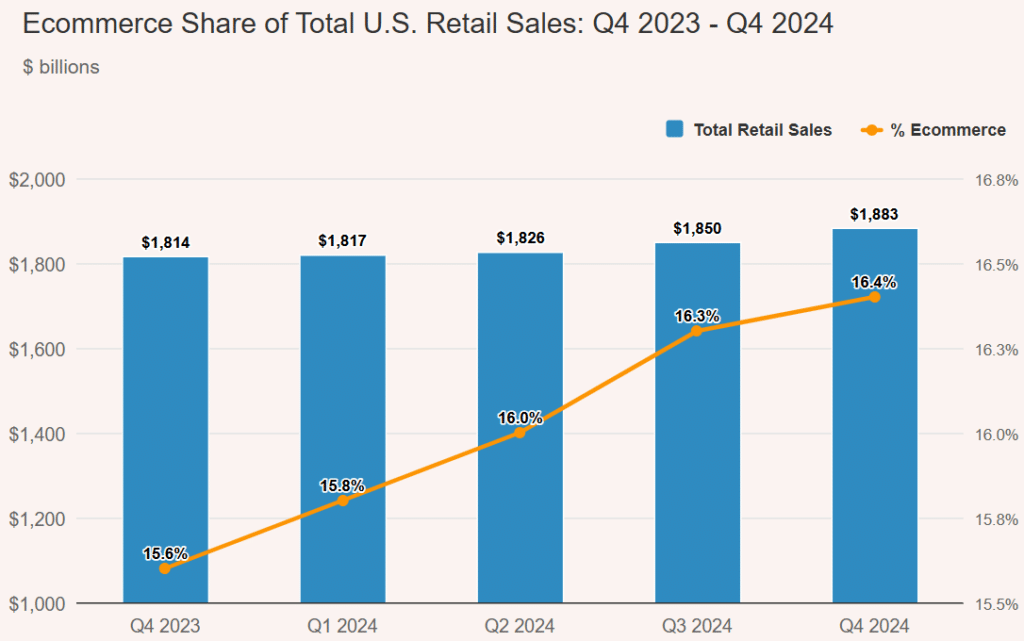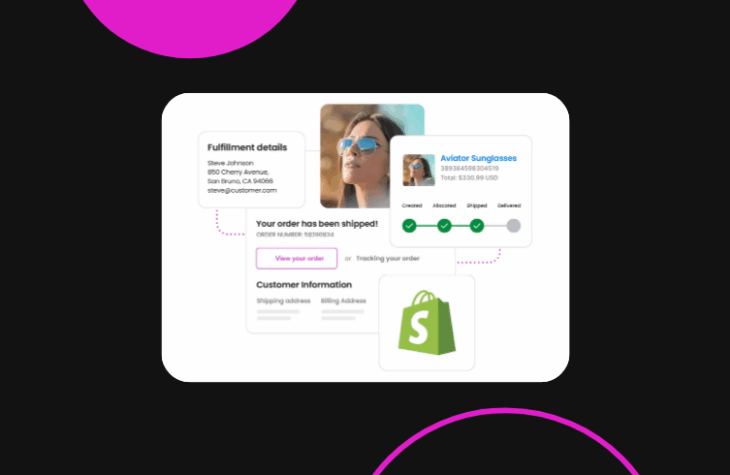Beyond the Basics: Supercharge Your Omnichannel Retail Strategy

Basic omnichannel setups on platforms like Shopify often lead to fragmented data and inconsistent customer experiences, hindering growth and increasing acquisition costs as modern shoppers expect seamless, multi-channel journeys.
Advanced order orchestration systems, like fabric’s AI-powered OMS, address these limitations by providing unified inventory views, intelligent fulfillment, personalized experiences, and seamless integration, enabling retailers to improve efficiency, customer satisfaction, and future-proof their operations.
Most retailers are now realizing that implementing an omnichannel retail strategy is not just an option, but a necessity. But simply having a presence across multiple channels isn’t enough. Basic setups often lead to siloed customer data, fragmented systems, and wildly inconsistent experiences that leave shoppers frustrated.
When e-commerce platforms can’t keep up with the pace of modern commerce, it results in missed opportunities, operational inefficiencies, and rising customer acquisition costs. According to the Harvard Business Review, 73% of shoppers use multiple channels during their customer journey, yet many retailers still struggle to create a seamless customer experience across all of them.
The landscape of omnichannel retail is evolving rapidly. With customers expecting faster delivery, personalized experiences, and real-time stock availability, retailers are under pressure to go beyond the basics. Today’s commerce demands smarter tools, flexible fulfilment, and systems that actually talk to each other. That’s where our advanced order orchestration comes in.
fabric is an AI-powered order management system (OMS) designed to modernize your operations and supercharge your Shopify setup. It delivers real-time inventory visibility, intelligent order routing, and actionable insights that can help you reduce split shipments and boost customer satisfaction, without overhauling your entire tech stack.
In this article, we’ll review the key limitations of standard Shopify-based setups and explore some advanced omnichannel strategy enhancements that can help you fulfil, engage, and retain customers. You’ll also learn how fabric, our flexible, composable platform, fits seamlessly into your retail ecosystem, unlocking powerful tools to create a truly customer-centric approach.
The limitations of basic Shopify omnichannel setups
While Shopify provides many functions, when it comes to supporting a fully evolved omnichannel retail strategy, its out-of-the-box capabilities can only take you so far. As customer expectations grow and shopping behavior continues to evolve, relying solely on default features can leave serious gaps in your operations.
Retailers operating on basic Shopify setups often face challenges like inventory visibility issues, delayed order syncing, and a lack of coordination between physical stores and online channels. It results in a disconnected customer experience where shoppers can’t reliably buy online and pick up in-store, or worse, find items available on your site that are out of stock in their local stores.
Manual processes and piecemeal systems create friction across customer touchpoints, leading to in-store fulfilment delays, duplicate entries, and missed sales. These inefficiencies not only impact operational flow but also erode customer loyalty and increase customer acquisition costs.
According to the U.S. Census Bureau, online purchases accounted for 16.4% of all U.S. retail sales in Q4 of 2024, reaching $308.9 billion, a 9.4% year-over-year increase. This continued growth shows just how quickly customer behavior is shifting, with more shoppers expecting to move seamlessly between digital channels and in-store experiences.

Source: PracticalEcommerce
The stakes are high. Without a unified system that consolidates customer data and keeps your sales channels aligned in real time, you’re simply not set up to deliver the kind of superior customer experiences that loyal customers now demand.
So, if your operations still rely on spreadsheets, staff workarounds, or disconnected apps to track customer purchases and fulfillment, it’s time to reconsider. Real growth and real retention require centralized control, real-time insights, and scalable systems that align with the entire customer journey.
Advanced omnichannel retail strategies
To succeed in today’s competitive market, you need more than just an active presence across multiple channels—you need a coordinated, scalable system that drives measurable operational efficiency. A modern omnichannel retail strategy should empower you to make smarter decisions, deliver personalized experiences, and adapt quickly to shifts in customer behavior.
Let’s explore five high-impact strategies that fabric enables to support a seamless, future-ready omnichannel customer experience.
Unified inventory view across all channels
One of the biggest challenges in omnichannel retail is keeping track of inventory across physical stores, warehouses, and online channels. Without real-time coordination, overselling and stockouts become common, and customer trust suffers.
fabric’s AI-powered order management system (OMS) offers real-time inventory visibility, pulling in valuable data from both first-party and third-party sources to provide a unified inventory view across all sales channels. This level of transparency can help you display product availability confidently and reduce fulfillment errors.
As a result, you’ll provide a smoother, more reliable in-store pickup experience, fewer cancellations, and an overall boost in customer satisfaction.
Intelligent order orchestration and fulfillment options
Fulfilling orders from multiple channels—whether it’s a central warehouse, local store, or dropshipping partner—comes with complex routing decisions. One last shipment or stock miscommunication can quickly lead to higher customer acquisition costs and missed expectations.
fabric’s configurable fulfillment engine optimizes routing using AI, evaluating real-time conditions like proximity, availability, shipping costs, and even weather patterns. Whether you’re managing B2C orders or complex fulfillment across 3PLs, it helps reduce split shipments and speed up delivery.
More importantly, our comprehensive OMS enables intelligent execution of services like BOPIS (buy online, pick up in store) and ship-from-store. These offerings not only meet customer expectations for fast and flexible fulfilment but also allow stores to move inventory efficiently while improving the in-store experience.
Personalized customer experiences powered by AI
Customers expect more than just convenience; they want to feel understood. That means using data to segment customers effectively and deliver tailored promotions, product suggestions, and content that align with their interests and needs.
fabric’s AI capabilities analyze unified customer data to deliver real-time personalized recommendations across all touchpoints—email, mobile app, social media, and even in-store interactions. This makes it easier to engage customers based on their preferred channels, browsing habits, or past online purchases. It also allows you to tailor each interaction based on evolving customer preferences, improving both relevance and satisfaction.
As a result, you’ll be able to build stronger customer relationships, see an increase in conversion rates, and ultimately increase customer lifetime value (CLTV).
Seamless integration with existing Shopify ecosystems
An effective omnichannel strategy shouldn’t require an entire rebuild of your existing tech stack. fabric is designed with an API-first, composable architecture, making it easy to plug into your current Shopify setup, alongside your ERP, CRM, POS, or other business systems.
This modular approach reduces integration time, supports phased rollouts, and gives you more control over how and when you scale. It’s the ideal way to reduce operational friction while creating a connected, customer-focused system that reflects every stage of the entire customer journey.
With less reliance on rigid, monolithic systems, you can launch new capabilities, like cross-channel inventory sync or cross-channel customer support, without disruption.
Scalability and future-proofing
As your business grows, so should your retail tech. Unfortunately, many retailers find themselves locked into platforms that cannot adapt quickly or are too expensive to change.
fabric’s cloud-native infrastructure, built on AWS, allows you to scale up quickly during high-traffic periods and expand to new digital channels without performance hiccups. Whether it’s preparing for seasonal demand or adding new sales channels, our platform is built to support long-term growth.
Additionally, with machine learning constantly feeding customer data back into the orchestration logic, you’re not just scaling—you’re improving. That means more accurate demand forecasting, improved fulfilment flows, and better outcomes across every customer touchpoint.
Make it happen: From strategy to execution
Now that you know what a truly advanced omnichannel retail strategy is like, let’s look into how you can implement it, practically and effectively. If you’re using Shopify, adopting a more innovative, data-driven approach can unlock operational efficiencies, improve the customer journey, and boost customer satisfaction at every stage.
Here’s a step-by-step playbook to bring your strategy to life:
1. Start with data centralization
To deliver a seamless omnichannel customer experience, your first step should be integrating unified customer data and real-time inventory updates across all sales channels.
Whether your customers compare prices on a mobile device, explore in a physical store, or shop from your website, your data needs to stay in sync.
Our comprehensive platform makes it easy to connect inventory and customer data from both owned and third-party systems. Our API-first infrastructure means that, even as a Shopify retailer, you can plug in fabric with minimal disruption, so your digital channels, ERP, and POS tools all speak the same language.
2. Phase in advanced fulfilment services
Once your systems are communicating, it’s time to roll out next-level fulfilment. Begin with features like BOPIS (buy online, pick up in store) or ship-from-store, and expand as your teams gain confidence.
With fabric, you can test, launch, and optimize these fulfilment services incrementally; no massive replatforming is needed. This lets you deliver a more flexible in-store experience while also improving shipping speed and reducing costs across the board.
Pro tip: We suggest starting with a few pilot locations before scaling to all your brick-and-mortar stores.
3. Personalize the experience across touchpoints
With your data unified, you can now deliver personalized experiences that align with your shoppers’ preferred channels and customer behavior. Use our platform’s AI capabilities to create personalized recommendations, automate merchandising, and run targeted marketing campaigns based on previous customer purchases, location, and even seasonality.
When done right, this kind of personalization doesn’t just drive revenue, it helps you retain customers and strengthen long-term customer relationships.
4. Optimize and scale without rebuilding
Scalability shouldn’t be a hurdle. With fabric, you can add new functionalities (like dropshipping, multi-location routing, or predictive analytics) as your business grows.
fabric’s modular and composable architecture gives you the flexibility to support growth without reinventing your stack. As your customer segments expand and expectations evolve, you’ll have the agility to keep up with the new retail industry, including emerging omnichannel retail trends and performance goals.
5. Try it before you do it
Implementing a next-gen omnichannel strategy doesn’t mean you have to tackle everything at once. A great first step is seeing what our comprehensive platform looks like in action. A personalized consultation can help you uncover quick wins and long-term opportunities that are specific to your use case.
Schedule a demo and learn how fabric can refine your Shopify experience to create a superior customer experience, reduce customer acquisition costs, and transform your retail strategy from the inside out.
Elevate your Shopify omnichannel experience
The retail landscape is evolving fast, and just like time, it will wait for none, so standing still isn’t an option. If your business is still relying on basic tools and disconnected workflows, you’re willfully leaving efficiency, revenue, and customer loyalty on the table.
With fabric, you can gain access to a platform purpose-built for modern omnichannel retail. From real-time inventory visibility and intelligent fulfilment to personalized experiences and seamless API-based integration, fabric empowers you to meet rising customer expectations across online and in-store experiences.
It’s not just about selling through multiple channels, it’s about doing it smarter. That means reducing customer acquisition costs, increasing customer lifetime value, and delivering the kind of experience that’d leave your customers wanting more.
Move beyond fragmented systems and manual workarounds to create a scalable, flexible retail strategy that truly aligns with how modern customers shop.
Contact our team of experts today to learn how you can integrate the elements of efficiency, flexibility, customer engagement, satisfaction, and loyalty into the fabric of your business and future-proof your business today!

Digital content editorial team @ fabric






